| Overview / Spiral ganglion / Neurotransmitters | |
| Scientific concept : M. Eybalin | |
| Drawings: S. Blatrix |
| Overview / Spiral ganglion / Neurotransmitters | |
| Scientific concept : M. Eybalin | |
| Drawings: S. Blatrix |
| Almost unknown in the early 90s, cochlear neurochemistry is now well documented at molecular anatomical level (refs. c3, c4, c5); in addition, physiological and pharmacological studies are now well developed. |
Neurotransmitters at IHC synapses
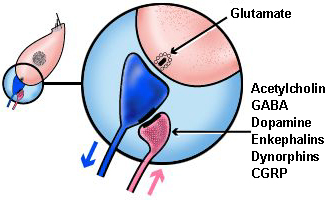
|
Glutamate as the afferent neurotransmitter |
|
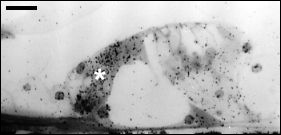 |
Glutamate (Glu) is the main candidate for neurotransmission at synapses between IHC and radial (type I) afferent dendrites. A large variety of findings support this idea, such as this specific autoradiographic labeling (asterisk) of the IHC, after tritiated glutamine loading (from ref. c.11). |
|
|
Molecular pharmacology is highlighting the main (sub)types of receptors (ref.c20). Among ionotropic receptors, GLUR2/3 of the AMPA type are the most active at the postsynapse under physiological conditions (ref.c16), and NR1 of NMDA type under noisy conditions (ref. c15). |
| Glutamate is a fast excitatory neurotransmitter, ideal for the IHC-auditory nerve synapse. However, due to its excitotoxic properties, it is responsible for spiral ganglion neuron pathologies. | |
|
Metabotropic receptors are also found, such as mR1, of which mRNA is expressed (see in situ-hybridisation picture on the right) both postsynaptically (in spiral ganglion neurons) and presynaptically (in the IHC, red arrows). The white arrow points to a non-specific labelling of the tectorial membrane.
|
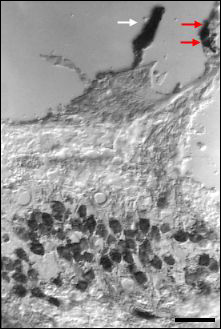 S.Safieddine |
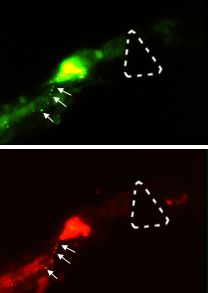 M.Eybalin |
As shown in the top schematic drawing, the lateral efferent endings contain a cocktail of neurotransmitters (see recent reviews). These pictures show an immunochemical co-localisation of metenkephalin (green) and dopamine (TH, red). White arrows point to co-localisation in efferent varicosities. |
| Immunocytochemistry of lateral efferent synapses | |
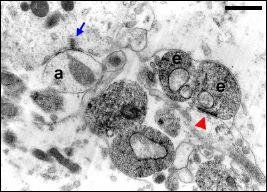 |
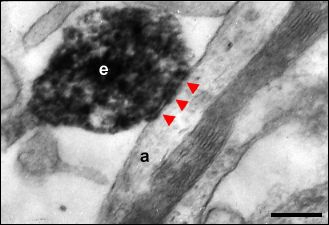 |
| M.Eybalin | R.Pujol |
|
The lateral efferent endings, synapsing
(red arrowheads) with the radial afferent dendrites below the IHCs,
contain a cocktail of neurotransmitters (see recent reviews):
ACh (as in ChAT-labelled endings in left picture), DA, Gaba, and neuropeptides
- enkephalins (as in MET-labelled ending in right picture), and dynorphins,
CGRP. Some of them, such as DA, are obviously there to protect
and/or help repair the afferent glutamatergic synapse (blue arrows). |
|
|
Neuroransmitters at OHC synapses |
|
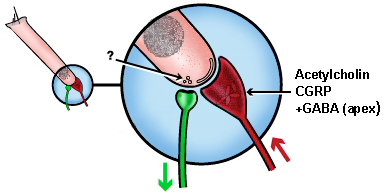 |
The neurotransmitter at the OHC-spiral (type II) afferent synapse is not known: perhaps glutamate but mediated via different types of receptors? |
| Medial efferent neurotransmitters | |
|
|
For the medial efferent synapses ACh (as in the huge ChAT-labelled ending on the left) looks to be the main candidate with, at the postsynapse, a new (alpha 9) type of nicotinic receptor which possesses some muscarinic properties. Gaba is possibly co-localised with ACh in most efferent synapses in the mid- and apical cochlea. Moreover, CGRP and ATP may well act as neuromodulators. scale bar: 0.5 µm |

|
For
permission to non-commercial use of any element of this site, please contact us All rights reserved © 1999 - 2007 The authors Intellectual property law 85-660 (07/03/1985) |
|